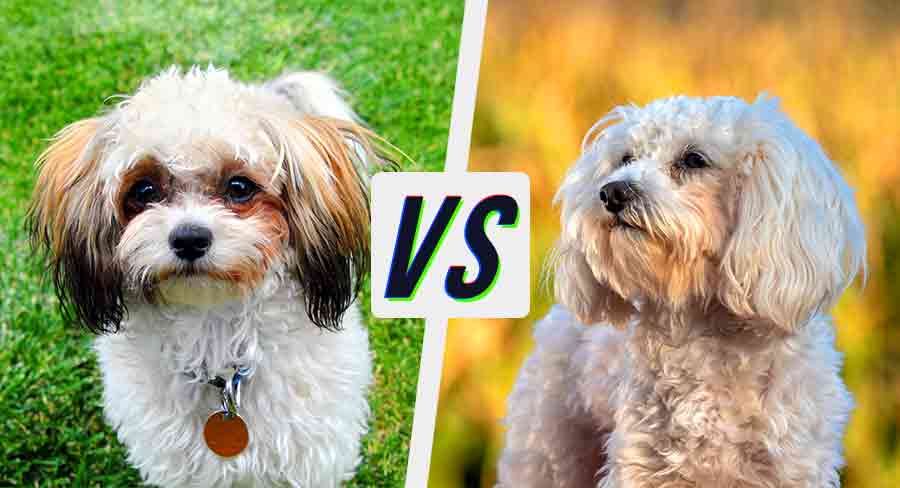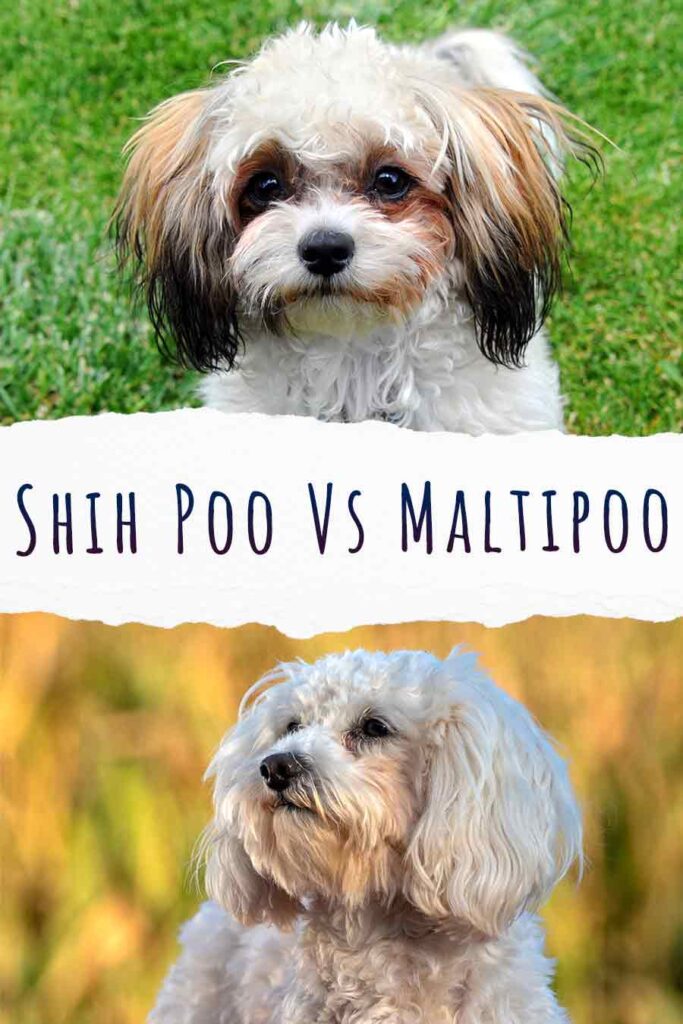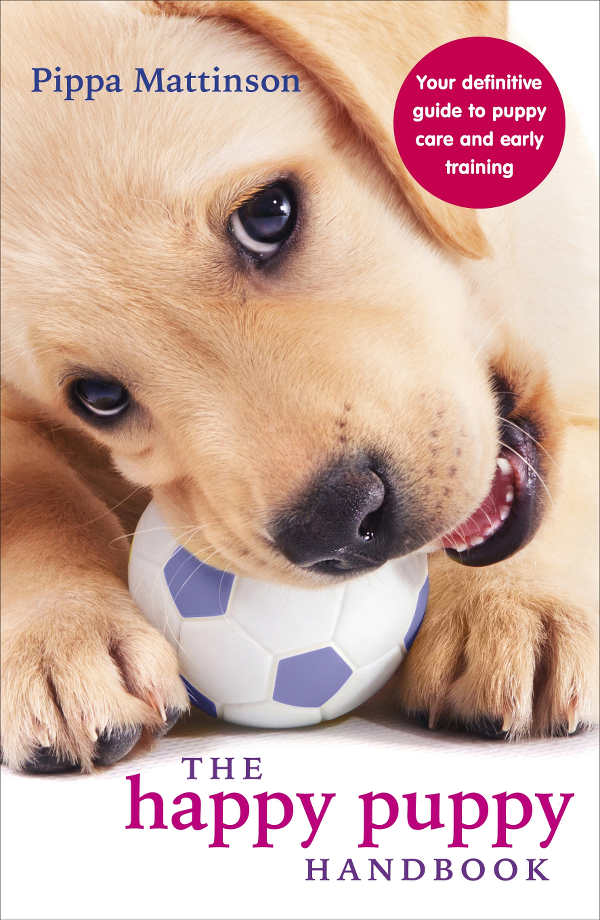
Choosing between a Shih Poo vs Maltipoo doesn’t have to be an impossible dilemma. This article gets to grips with all the similarities and differences between them, so that you can pick a puppy with confidence!
Shih Poos are a cross between a Shih Tzu and a Toy or Miniature Poodle. And Maltipoos are a mix of Maltese and Toy or Miniature Poodle. Since both mixes combine a Poodle parent with a popular breed from the Toy dog group, they have a lot in common. However, depending on your circumstances, and what you’re looking for in a dog, one is likely to be slightly better suited to you than the other.
You can use these links to navigate to the Maltipoo vs Shih Poo differences you’re most interested in, or scroll down to learn them all!
- Shih Poo vs Maltipoo at a glance
- Spot the difference – Shih Poo vs Maltipoo appearance
- Contrasting coats
- Shih Poo vs Maltipoo temperament
- Which is easier to train?
- Who needs more exercise?
- Shih Poo vs Maltipoo health
- Which one is right for me?
Both mixes have the potential to be great companion dogs – let’s start with an overview of why they might make your dog breed shortlist.
Shih Poo vs Maltipoo at a Glance
Shih Poos and Maltipoos have both gained popularity thanks to an explosion of interest in mixed breed dogs generally. And in particular, ‘designer dogs’ with parents from two different pedigrees. This table sums up how they compare to each other:
| Shih Poo | Maltipoo | |
|---|---|---|
| Height | 10 - 15 inches | 7 - 14 inches |
| Weight | 4 - 16 pounds | 4 - 15 pounds |
| Popular colors | Black, brown, tan, and apricot | Cream or white |
| Coat | Long, wavy or curly, and non-shedding. May be doubled coated. | Medium to long with a wavy, fluffy texture |
| Temperament | Smart, playful, confident | Playful, charming, affectionate |
| Lifespan | 10 - 15 years | 12 - 13 years |
Do you think you could tell a Shih Poo from a Maltipoo at first glance? Let’s find out!
Shih Poo vs Maltipoo Appearance
Shih Poos and Maltipoos are both highly variable in size, so it’s impossible to choose between them based on this alone. Take a look at the sizes of all the possible parents:
- Toy Poodle: 4 – 6 pounds
- Maltese: 6 – 7 pounds
- Shih Tzu: 9 – 16 pounds
- Miniature Poodle: 10 – 15 pounds
So a Maltipoo from a Toy Poodle will be very small indeed – just 4 to 7 pounds. And a Shih Poo from a Miniature Poodle will be twice the size – 9 to 16 pounds. In between, you can also get Maltipoos from Miniature Poodles which outweigh Shih Poos from Toy Poodles. So if size is important to you, it’s not which mix you pick that matters, but the size of your puppy’s own parents.

Both dogs come from parents with small, round faces and big dark eyes. So when it comes to cuteness, we’ll call it a draw. One of the most distinctive things about either mix is likely to be their coat, so we’ll look at how they compare in closer detail next.
Shih Poo vs Maltipoo Coat
Poodles and Shih Tzus both come in a kaleidoscope of attractive colors. But Maltese breeders are purists – only white, with perhaps the tiniest hint of lemon or tan, will do. This doesn’t necessarily mean Maltipoos come in fewer colors than Shih Poos though, since Maltipoos can inherit their color from their Poodle parent.
Shih Tzus and Maltese both have long, straight coats, non-shedding coats. But only the Shih Tzu has a dense, double coat, whereas the Maltese’ coat is distinctly finer and silkier. Shih Poos and Maltipoos will both have non shedding coats that require frequent brushing and monthly trips to the groomer. But the exact texture and amount of curl in their coat will vary from individual to individual.
Poodle mixes owe a lot of their popularity to the potential for inheriting a Poodle’s curly, low-shedding coat. It makes them a popular choice for people who are turned off by the prospect of dealing with shed hair. And you might see the Poodle-type coat being described as hypoallergenic too. However, the reality is that all dogs produce allergens, because those allergens are found in their saliva (and to a lesser extent their sweat and urine), not in their hair. So neither the Shih Poo nor the Maltipoo is guaranteed to be suitable for people with allergies.
Shih Poo vs Maltipoo Temperament
Whenever dogs from two different pedigrees mate, there is no way to tell what combination of personality traits their puppies will inherit from each breed. They could take after one parent more than the other, or be a complete mashup of both. There’s even a lot of variation between siblings from the same litter. Furthermore, environment and the amount of socialization they receive also affect temperament.
In general, Shih Poos tend to be friendly, playful pups who love chasing a ball and playing with their toys. Some may be a little shy around strangers but will love to cuddle up with their owners. Maltipoos are also very affectionate dogs, who like to be active. They may tend to exhibit destructive behavior if they don’t get enough exercise or attention.
One less-than-endearing quality these two crosses share is a tendency to bark. It can be a hard habit to break, but there are ways to train a dog not to bark. And we’ll look more at training next.
Shih Poo vs Maltipoo Trainability
Poodles are known for being extremely intelligent. They are widely regarded as one of the easiest dogs to train – both because they are clever, and because they are easily motivated to want to train. Shih Tzus and Maltipoos are also intelligent, but they are more likely to be described as stubborn in training sessions. They’re not actually being wilfully difficult, it’s just that they have no working history. So they come across as less engaged in training – especially considered next to the cooperative Poodle!
On balance, Shih Poos and Maltipoos are both likely to be at least moderately easy to train. Tricky areas may include:
- Toilet training for very small dogs. Maltipoo from Toy Poodles are likely to be tiny, and have tiny bladders to match. This can make toilet training a much longer and more labor intensive process.
- Separation anxiety. Shih Tzus and Maltese were both bred to provide humans with company. Which means they aren’t very well equipped to spend long periods of time by themselves. Either of these mixes need to be taught how to spend time alone very gradually, and their maximum tolerance for it might be quite low.
Shih Poo vs Maltipoo Exercise Requirements
Even small dogs need daily exercise to stay fit and burn off energy to avoid destructive behaviors. Both of these mixes need 30 to 60 minutes of daily outdoor exercise. Which could consist of a short walk, run, or playing in the yard. Larger dogs between 13 and 16 pounds will have more stamina for hikes and days out than small dogs under 7 pounds. Exercise doesn’t end with outdoor activity though – both of these mixes will need outlets for their physical energy at home. Such as toys and training games. Since both these mixes are part Poodle, there’s a good chance that they will enjoy swimming too!
Shih Poo vs Maltipoo Health
Mixed dogs are susceptible to health issues that affect their parent breeds. Responsible breeders screen for hereditary health conditions, so it’s important to be aware of which certificates to expect.
Common hereditary problems of the Toy and Miniature Poodle include:
- Cushing’s disease a serious condition commonly caused by a tumor in the pituitary gland that usually affects older dogs.
- Patella luxation An orthopedic disorder of the knee.
- Tracheal collapse In which the windpipe impairs the dog’s ability to breathe.
- Von Willebrand’s disease A bleeding disorder.
- Epilepsy
- Hypothyroidism
- Diabetes
Health Problems of Shih Tzus
Shih Poos can also inherit health problems through their Shih Tzu parent. Shih Tzus are one of the brachycephalic or flat-faced breeds. While their short muzzle is one of the things that make these dogs so cute and popular, it also causes them severe respiratory problems and eye disease.
Shih Tzus are also prone to:
- Hip dysplasia
- Degenerative myelopathy A neurological disease.
- Tooth decay
Maltese Health Problems
Maltese dogs are another brachycephalic breed. Besides the complications of this, they are also vulnerable to:
- Hip dysplasia
- Patella luxation
- Degenerative myelopathy
- Tooth decay
- Tracheal collapse
- White shaker dog syndrome A condition causing mild to severe shaking or shivering tremors that make it difficult to stand or walk.
- Heart murmurs and an irregularity called Patent Ductus Arteriosus
- Gastrointestinal disorders Such as inflammatory bowel disease that can cause vomiting, diarrhea, or weight loss.
Choosing Between a Shih Tzu vs Maltipoo for Health
Shih Poos and Maltipoos each have their own unique profile of health risks. Choosing a puppy from a responsible breeder who only uses health tested sires and dams increases the likelihood that your dog will have a long, healthy life. Exercising them carefully to protect their joints, using a harness to reduce the risk of tracheal collapse, and sticking to a regular schedule of vet checks are all things you can be proactive about, to ensure their long term health.
Shih Poo vs Maltipoo – Which One is Right for Me?
Both the Shih Poo and Maltipoo are small companion dogs who like to snuggle and love human company. Either of these energetic, playful pups can adapt to small living spaces and will fit into most homes. But neither is likely to cope well with being left alone for long periods – something to consider if you work full time.
Something else to consider is how much time you hope to spend walking with your dog. If you’re outdoorsy, a Shih Poo from a Miniature Poodle will be able to keep up on most hikes. But a Maltipoo from a Toy Poodle will get left behind on all but the shortest strolls.
Choosing the right mix may also hinge on who else lives with you. Toy Poodles, Malteses, and their crosses all have small, delicate frames. They are very vulnerable to injury if a boisterous child plays with them too roughly. So a Shih Poo from a Miniature Poodle is a most robust choice for families.
Are you having trouble deciding between the Shih Poo and Maltipoo? Or have you ever had one of these mixes in your life? We would love to hear your thoughts in the comments!
You’ll Also Enjoy
If you love Maltipoos and Shih Tzus, then you’ll also enjoy these articles:
- Miniature Poodle Dog Breed Information Center – The Mini Poodle Guide
- Toy Poodle – All About The World’s Cutest, Curliest Dog Breed
- Shih Tzu Temperament – How Does This Classic Breed Behave?
- Maltese Dog Breed Information Center: The Ultimate Fluffy White Puppy
- Maltese Shih Tzu Mix – Is This The Perfect Pint Sized Pet?
References and Resources
Allan. Endocrine alopecia in a Miniature Poodle. New Zealand Veterinary Journal. 1995.
Randolph. Factor XII deficiency and von Willebrand’s disease in a family of miniature poodle dogs. The Cornell Veterinarian. 1986.
Priester. Sex, Size, and Breed as Risk Factors in Canine Patellar Dislocation. JAVMA. 1972.
Hoffman. Canine hyperadrenocorticism associations with signalment, selected comorbidities and mortality within North American veterinary teaching hospitals. JSAP. 2018.
Hess. Breed distribution of dogs with diabetes mellitus admitted to a tertiary care facility. JAVMA. 2000
Tappin. Canine tracheal collapse. Journal of Small Animal Practice. 2016.
Trappler. Canine Brachycephalic Airway Syndrome: Surgical Management.(paid link) Compendium: Continuing Education for Veterinarians. 2011.
Christmas. Common ocular problems of Shih Tzu dogs. The Canadian Veterinary Journal. 1992.
Priester. Canine intervertebral disc disease — Occurrence by age, breed, and sex among 8,117 cases. Theriogenology. 1976.
Bagley. Tremor syndromes in dogs: Diagnosis and treatment. Journal of Small Animal Practice. 1991.
The Korean Society of Veterinary Clinics. Transarterial Coil Embolization in Two Maltese Dogs with Patent Ductus Arteriosus Using a Mini Cobra-tip Angiocatheter. Journal of Veterinary Clinics. 2010.

Leave a Reply